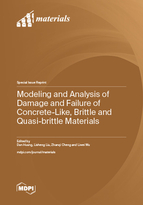Modeling and Analysis of Damage and Failure of Concrete-Like, Brittle and Quasi-brittle Materials
A special issue of Materials (ISSN 1996-1944). This special issue belongs to the section "Construction and Building Materials".
Deadline for manuscript submissions: closed (31 July 2023) | Viewed by 20611
Special Issue Editors
Interests: computational mechanics; damage and fracture; peridynamics; fluid–structure interaction; multi-scale modeling; multiphysics analysis; concrete materials and structures; functionally graded materials; data-driven analysis
Special Issues, Collections and Topics in MDPI journals
Interests: computational mechanics; dynamics behavior of materials; peridynamics; fluid–structure interaction algorithm; multi-scale finite element method; extreme mechanical behavior and modeling of materials
Special Issues, Collections and Topics in MDPI journals
Interests: computational mechanics; damage and fracture; peridynamics; cement-based composites; multi-scale modeling; micromechanics; functionally graded materials
Special Issues, Collections and Topics in MDPI journals
Interests: peridynamics; concrete failure; numerical modeling; dynamic fracture
Special Issues, Collections and Topics in MDPI journals
Special Issue Information
Dear Colleagues,
Modeling and analysis of damage and failure of materials and structures is an active and persistent challenge in computational mechanics, materials, and various scientific and industrial fields. This Special Issue provides an informative and stimulating forum to enhance academic communications on this challenging topic, focusing on the development and applications of computational theories, numerical and experimental methods, models, and algorithms for modeling and analyzing damage and failure of concrete-like, brittle, and quasi-brittle materials and structures.
Potential topics include—but are not limited to—failure mechanisms and experimental and numerical analyses of concrete-like, brittle, and quasi-brittle materials and structures; multi-scale models and methods for deformation and failure analysis; fluid–structure interaction; concrete corrosion; durability of concrete-like materials and structures; thermomechanical coupling and other multi-physics fracture modeling; dynamic fracture studies; numerical methods and approaches for damage and failure modeling; and data-driven computational mechanics and modeling.
Prof. Dr. Dan Huang
Prof. Dr. Lisheng Liu
Prof. Dr. Zhanqi Cheng
Dr. Liwei Wu
Guest Editors
Manuscript Submission Information
Manuscripts should be submitted online at www.mdpi.com by registering and logging in to this website. Once you are registered, click here to go to the submission form. Manuscripts can be submitted until the deadline. All submissions that pass pre-check are peer-reviewed. Accepted papers will be published continuously in the journal (as soon as accepted) and will be listed together on the special issue website. Research articles, review articles as well as short communications are invited. For planned papers, a title and short abstract (about 100 words) can be sent to the Editorial Office for announcement on this website.
Submitted manuscripts should not have been published previously, nor be under consideration for publication elsewhere (except conference proceedings papers). All manuscripts are thoroughly refereed through a single-blind peer-review process. A guide for authors and other relevant information for submission of manuscripts is available on the Instructions for Authors page. Materials is an international peer-reviewed open access semimonthly journal published by MDPI.
Please visit the Instructions for Authors page before submitting a manuscript. The Article Processing Charge (APC) for publication in this open access journal is 2600 CHF (Swiss Francs). Submitted papers should be well formatted and use good English. Authors may use MDPI's English editing service prior to publication or during author revisions.
Keywords
- concrete-like materials and structures
- quasi-brittle materials
- damage and failure
- dynamic behavior
- experimental analysis
- numerical methods
- multi-scale modeling
- multi-physics modeling
- corrosion
- durability










